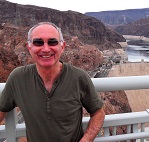


|
|
|
|||||||||||||||
|
|
||||||||||||||||
|
|
|||
|
|
Arizona / Nevada Hoover Dam
The Hoover Dam is located in the Black Canyon on the Colorado River, spanning the state line between Arizona and Nevada. Constructed between the years of 1931 and 1935 during the Depression, its purpose was to control the flooding of the Colorado, which, prior to its construction, would happen on a regular basis, causing destruction, misery and loss of life. It would also enable the irrigation of the surrounding area, providing greater productive use of the land, and harness the power of the river enabling electricity to be produced in order to supply Arizona, Nevada and California. Its construction design is an Arch-gravity Dam, which functions by holding back the water by a combination of its weight and mass and by transferring any pressure onto the walls of the canyon. In order to do that, a suitable location had to be found which would enable it to span the distance between the two sides of the canyon and provide a suitable ground structure to rest on. Initially known as the Boulder Dam - as it was originally intended to be constructed in Boulder Canyon - it had to be re-sited as that location was deemed to be unsuitable. It was renamed the Hoover Dam after President Herbert Hoover. The Chief Engineer for the project was Frank Crow, whose reputation was that of a hard and cruel man - traits that ensured the completion of the project ahead of cost and two years ahead of programme. The construction process involved five phases: Surveying; the establishment of the infrastructure and accommodation; diverting the Colorado River; preparation of the ground and the construction of the Dam. Initially, the workers (and many of their families) lived in tents until the construction of a purpose-built town 7 miles from the Dam site. This consisted of barracks, housing, stores and general public welfare facilities with churches and schools for the children. This town was to become Boulder City. Infrastructure was required to get the workers and materials to the site, which involved the construction of 7 miles of roadway from Boulder City to the Dam site and a 22 mile railway from Las Vegas to Boulder City and then on to the Dam. Electricity was also needed and that involved the construction of a 220 mile power line. The work on the construction required the diversion of the Colorado River. This was done by digging four tunnels through the sides of the canyon walls with each tunnel being over three quarters of a mile (1200 metres) long. This was a difficult and dangerous task with many workers suffering from the effects of carbon monoxide poisoning from the vehicle fumes as well as injuries from the dangers of rock blasting. The tunnels were then lined with concrete, using moveable sections of steel forms. Pneumatic concrete guns were used to fill the overhead forms, resulting in a concrete lining that was 3 feet (91 cm) thick. Once the tunnels were completed, the river could be blocked to divert it through the tunnels, leaving the proposed site clear for the construction work on the Dam to begin. The first task was to excavate down to bedrock to a depth of 40 feet (12 metres). At the same time the "High Scalers" worked on the canyon walls. Their job was to remove any loose rocks to provide a good key for the concrete. The first concrete was poured on 6th June, 1933. The base alone required 230 individual blocks of concrete. Five-foot tall blocks of varying width, ranging from 25 square feet (2.3 Sq m) on the downstream face to 60 square feet (5.5 Sq m)for those facing upstream. The blocks were linked together like a giant Lego set with a system of alternating vertical and horizontal schemes. The total amount of concrete used was 3,250,000 cubic yards for the Dam plus a million for the power plant, intake towers and other support structures. Two batch plants were created on site to produce the concrete which was transported to the required location on railcars in large four and eight cubic yard buckets and then by an overhead cableway system, which lifted the buckets and lowered them to the forms. At peak production, one bucket was delivered about every 78 seconds. The chemical heat generated by concrete setting was dissipated by embedding over 582 miles (936 km) of one-inch steel pipe through the interconnecting concrete blocks that circulated ice water produced by an on-site ammonia refrigeration plant that cooled the water. The cooling pipes were subsequently filled with concrete to create added strength. Without the coolant it would have taken 125 years for the concrete to cool down. It wasn't just the dam itself that had to be built. It also required intake towers, and a Spillway. 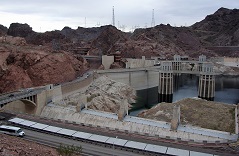 The Intake Towers, of which there are four are 396 feet (285 m) high and control the supply of water for the generators.
These take in the water and feed it through concrete lined tunnels 37 and 50 foot (11 and 15 m) in diameter in order to turn the power plant turbines. The generated power then goes to the transformers located on the concave side of the Dam and to be distributed.
In order to prevent water from flowing over the dam if water in the lake gets too high a spillway is provided which will allow water to flow through tunnels and be discharged downstream from the Dam.
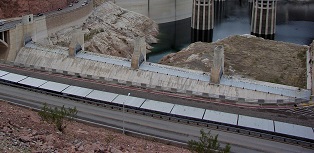 The construction of any dam produces a reservoir or lake; for the Hoover Dam this is Lake Mead, at which has been created a water recreation area. A slow filling process was required to lessen the pressure change on the Dam and to help prevent small earthquakes due to land settlement. The project required over 7,000 workers and 200 engineers. 96 people were officially killed during construction, but this only includes the people who actually died on site. If an injured worker was removed from the site and died later, they were not counted as having been killed during construction, and their dependants were therefore not entitled to compensation. A memorial exists at the dam for those who died, and a statue dedicated to the “High Scalers” is also there. 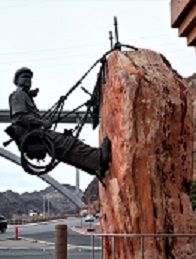 In addition to those killed during construction, over 25 men, women and children died in the first June-July period due to the extreme heat. The financial cost of the dam was $125 million, which equates to approximately $1.7 billion at current valuation.
More than one million people visit the Dam each year and the Dam has a visitors’ centre. This includes a museum, and tours are available into the Dam itself. 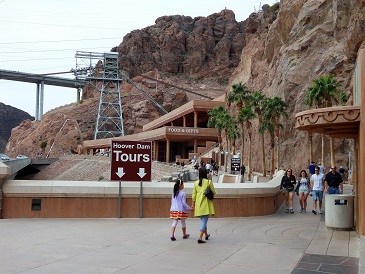 In recent years, transport to the Dam had become a problem. Prior to 2010 all traffic passed over the Dam but in 2010 the Hoover Dam Bypass project was completed. The project, which included up of four miles of dual carriageway, eight bridges, wildlife crossings, and a 2,000 foot (610 m) long arch bridge over the Colorado River as well as various pedestrian and visitor improvements, was started in 2003. The arch bridge is named the Mike O'Callaghan–Pat Tillman Memorial Bridge, after Mike O'Callaghan, Governor of Nevada from 1971–1979, and Pat Tillman, a football player who left his football career to enlist in the United States Army and was later killed in Afghanistan. The Hoover Dam was a ground-breaking engineering project that was to influence the construction of dams and have a major effect on the area.
To see more photographs and take a virtual tour of the site click on the photoshow below.
Addition information can be seen on Encyclopaedia Britannica
|
|
|
|
|
|||
All Photographs were taken by and are copyright of Ron Gatepain
| Site Map |
